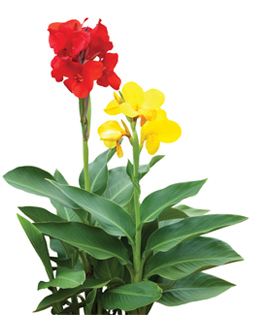Gardening with Tropical Plants
Adding tropicals to your garden in the Lehigh Valley? It’s easier than you think; and, there are surprising species that, yes, can be perennial. How about banana, bamboo and hibiscus?
Two Lehigh Valley garden designers weigh in on how to achieve a tropical look right here in planting Zone 6 using plants that only seem exotic to our region.
POTTED
Bruce Fritzinger, partner and manager of landscape architecture at Plantique®, says many tropical plants are quick-growing, like annuals, and can be used in big pots. “Caladiums, ferns, cannas, impatiens (who knew these tried-and-trues were really tropicals?) and philodendrons work well along with other annuals,” says Fritzinger. “They give luxuriant foliage and can be brought inside for the winter.” In fact, most everyday house plants are tropicals and do well when moved outdoors for the summer.
Fritzinger advises making sure plants are placed properly, and the sun is not too intense for them, as they naturally grow in tropical forests in filtered light.
Scott Rothenberger, owner of Scott Rothenberger’s Place, uses tropical plants extensively, not only for his clients, but also on his own property. “They add instant architecture to your landscape,” he explains, “and the element of surprise.” For instance, place a palm, banana or snake plant (Sansevieria trifasciata Prain) in the center of a large pot to add structure. Then fill in with such annuals as coleus, begonias, dusty miller, sweet potato vines and other annuals from your garden center.
Rothenberger achieves spectacular results with plants like castor bean (Ricinus communis), elephant ears (Colocasia esculenta) and cannas (in many varieties). Ornamental grasses also work well as anchors and add contrast to leafy plants.
If you have a sunny spot and enough space indoors for overwintering, dwarf citrus trees such as lime, lemon and orange (although not strictly tropical), not only draw admiring comments but also provide fruit when properly cared for. They easily transition outdoors in summer for rapid growth.
PLANTED
What about tropical or tropical-looking perennials in beds and gardens? Hardy hibiscus produces spectacular blooms. They need good soil and full sun, along with spring pruning. Rothenberger likes a variety called Kopper King for its giant blooms and tropical feel.
He also uses Big Blue Sea Holly (Eryngium x ‘Big Blue’) with its spiky blue flowers and stems and Bergenia cordifolia, which spreads as ground cover and produces large leaves and pink blossoms on thick stalks. Iridescent purple leaves make Persian Shield another favorite. Other hardy plants that work with a tropical theme are Lantana, Bird of Paradise, Passion Vine and Moonflower. This vine’s large, white fragrant blossoms open late in the day, adding a romantic touch on a warm summer night.
Canna lilies are true tropicals with lush foliage and big flowers. The hardy type has been adapted for cold climates. They come in many varieties and can achieve heights of 60 inches. However, their rhizomes must be dug up each fall and replanted in spring.
To fill in, Rothenberger likes ornamental grasses. “Florida grass (Miscanthus Floridulus) has plumes that have a tropical feel,” he says, “and they reach six feet by June.” Red Fountain (Pennisetum Princess) also contributes to a tropical scheme with its burgundy foliage and pink/red plumes.
Japanese fiber banana (Musa Basjoo) will thrive when planted in a well-drained, sunny spot. This writer’s yard boasts a plant that has achieved heights of up to 12 feet and produced shoots that are now thriving in friends’ yards across the Lehigh Valley. The only care it needs is to be cut down in fall, heavily mulched and covered with a tarp until spring. Bananas grow taller with each growing season as roots deepen and spread.
Hardy Bamboo (Nandina domestica) is a bit controversial. Fritzinger says it must be planted with barriers around it, even though some varieties are sold as non-invasive. “It will come up through concrete or asphalt, and I’ve even seen it take over a pool,” he explains. Rothenberger, however, has used the clump-forming variety as screening with success. Both men advise caution when considering planting bamboo.
If you’re longing to recreate your favorite tropical paradise at home, these designers advise using your imagination and these ideas to get started.
Sources:
Plantique, Inc.®
6344 Schantz Road
Allentown, PA 18104
610-395-6940
plantique.com
Scott Rothenberger’s PLACE
86 Laura Drive
Barto PA 19504
610- 428-1801
designbyplace.com
For information on growing dwarf citrus, check this site: squidoo.com/indoorfruittrees





